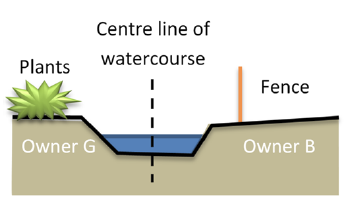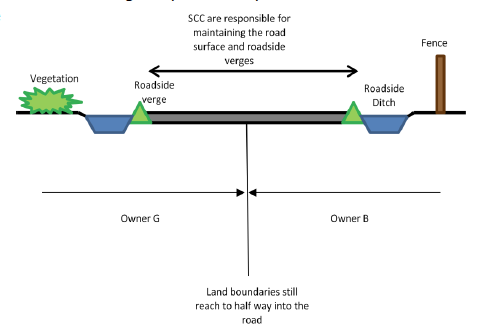Riparian ownership. - Who has responsibilty for maintaining ditches?
We only have a few watercourses in the parish. If you know you are, or after reading this guidance you realise you are a riparian owner please can you check the watercourse/s you are responsible for and maintain them as required.
The following information has been provided by Surrey County Council (Riparian Owners FAQs)
Riparian Ownership; Frequently Asked Questions
What is a watercourse?
A watercourse is…
every river, stream, brook, ditch, drain, culvert, pipe and any other passage through which water may flow. A watercourse can be either natural or man-made. Watercourses drain the land, prevent flooding and assist in supporting flora and fauna. Historically, watercourses have taken water runoff from buildings and roads, as well as fields and parks. In the process of development many have been culverted (piped) or changed in other ways.
In normal conditions a watercourse may be a dry channel in the ground; in heavy storm conditions it may become a raging torrent. Watercourses do not include public sewers but it could be in a pipe under the ground.
A Main River is…
usually a larger stream or river. However, locally important smaller watercourses can be designated as Main Rivers. The Environment Agency has authority, powers, rights and responsibilities for managing Main Rivers in England and Wales; a ‘Flood Map’ detailing their locations can be found on the Environment Agency website at www.environment-agency.gov.uk.
An Ordinary Watercourse is…
any other river, stream, ditch and culvert not defined as Main River. The responsibility for maintenance of ordinary watercourses lies with anyone who owns land or property adjacent to a watercourse. This is known as Riparian Ownership
It may not always be possible to see a clear physical difference between watercourses designated as either Main River or Ordinary Watercourse.
What is a Riparian Owner?
A riparian owner is the person, or people, with watercourses on, next to or under their property. Riparian owners have the responsibility for maintenance of these watercourses. Riparian responsibilities usually lie with the person who owns the land or property but may be the tenant depending upon the agreement in place.
How do I know if I am a riparian owner?
Unless otherwise shown on the Title Deeds, all of the land owners in this picture would normally be riparian owners up to the middle of the watercourse:
House A is responsible for the all of the watercourse running through their garden
House B is responsible for the watercourse behind the fence at the bottom of their garden
House C is responsible for the watercourse behind the fence AND the pond
House D is responsible for the culverted (piped) watercourse buried in the ditch in front of their land AND the underground pipe which runs beneath their property to the pond House E is responsible for the open ditch in front of their house AND the piped section under their access bridge
House F is responsible for the watercourse at the end of their garden behind their hedge
Landowner G is responsible for both the watercourses running along the edges of their land AND the pond
How much of the watercourse am I responsible for?
If both banks of a watercourse runs through (or under) your land, you are fully responsible for its maintenance. If it runs adjacent to your land (even does not fall within your property boundary as set out by your Title Deeds e.g if it is the other side of a boundary fence) then you are likely to be responsible for the maintenance of the watercourse bank on your side, to halfway across the bottom of the watercourse.
Using the example properties above, Owners G and B would each have responsibility for the maintenance of their side up to the middle of the watercourse. So unless the landowners’ Title Deeds show otherwise, it is presumed that each party owns to the centre line of the watercourse.
Depending upon the specific situation regarding land ownership, the responsibilities may vary and local advice should be sought if in doubt.
What are my responsibilities as a riparian owner?
The riparian responsibilities under law are:
To pass on water flow without obstruction, pollution or diversion that would affect the rights of others.
To maintain the banks and bed of the watercourse (including any trees and shrubs growing on the banks) and any flood defences that exist on it.
To maintain any approved structures on their stretch of the watercourse and keep them free of debris. These may include trash screens, culverts, weirs and mill gates.
Riparian Owners must not build new structures (for example a culvert, bridge or board walk) that encroach upon the watercourse, or alter the flow of water or prevent the free passage of fish without first obtaining permission from the Lead Local Flood Authority (Surrey County Council) or Environment Agency.
Do I have any rights as a riparian landowner?
Yes! Riparian Owner rights are:
To receive a flow of water in its natural state, without undue interference in its quantity or quality
To protect their property against flooding from the watercourse and to prevent erosion of the watercourse banks or any nearby structures
A Riparian Owner usually has the right to fish in the watercourse, provided legal methods are used. A rod licence will usually be required from the Environment Agency.
A Riparian Owner can abstract a maximum of 20 cubic metres of water per day for the domestic purposes of their own household or for agricultural use (excluding spray irrigation) without a license. Most other types of abstraction will require a license from the Environment Agency. If the water is to be used for drinking the abstraction must be registered with the District or Borough Council.
I’m not sure which land I own. How can I find out?
If you are not sure where exactly the border of your land is there are various ways you can find out; from having a chat with your neighbours and checking your property deeds or contacting the Land Registry. Be aware the title deeds for the property may not show the watercourse within your property boundary.
What if I am a tenant?
Riparian responsibilities generally sit with owner of the land but you still will have a responsibility not to block the free flow of water. It is worth checking your tenancy agreement and talking to your landlord. Even so, you should be careful not to allow things like rubbish or grass cuttings to get into the watercourse as this may cause a blockage.
There is a ditch running outside my property – surely that’s not my responsibility?
If it runs adjacent to your land and even if does not fall inside your property boundary as set out by your Title Deeds (e.g if it's the other side of a fence, wall or hedge), then you are likely to be responsible for the maintenance of the watercourse bank on your side, to halfway across the bottom of the watercourse. So unless the Title Deeds show otherwise, or the land is clearly owned by someone else, it is presumed that each party owns to the middle of the watercourse.
The ditch by my property runs alongside a road – is it the responsibility of Surrey County Council’s Highways Team to manage it?
The riparian owner of any ditches alongside roads is normally the adjoining landowner, as the highway boundary invariably lies along the top of the bank closest to the road. Adjacent owners should not carry out any work on the ditch which would restrict road surface water draining into it. Although the County Council and Highways Agency in their role as the Highway Authority has the right to discharge rainwater from the
highway into these ditches, the
landowner is responsible for
maintaining it.
What about if a stream runs underneath my property?
If a watercourse runs underneath your property or land in a culvert or pipe it is still your responsibility to keep it clear of debris and running freely. Underground culverted watercourses are more likely to occur in urban areas where historic development has taken place. It is important that you carry out regular maintenance, as if a culvert blocks it can causing flooding upstream for which you may be liable. There are many drainage companies that can inspect and clear culverts and offer you specialist advice on management.
If a culvert runs along the boundary of two landowner's land, they are jointly responsible for the culvert. Surrey County Council may be able to tell you if you have an underground watercourse on your land.
Can I just fill in the ditch if it is on my property?
No. These watercourses generally fulfil an important role in preventing local flooding. Plans for any works on ordinary watercourses, other than general cleaning and routine maintenance such as the removal of weeds or debris, must be approved by Surrey County Council. Consent for the work must be secured before starting. This applies to any changes which might affect the flow or capacity and include installation of dams, weirs, mills, channel diversions and in particular, culverting or piping.
How do I maintain the watercourse?
We have produced a guide called “Good Practice for Watercourse Maintenance” which tells you in detail all you need to know, but in summary maintenance should include; keeping vegetation under control (especially preventing large trees from blocking the watercourse), removing any obstructions to the flow of watercourse such as grass cuttings, litter and other debris and regularly removing silt to prevent it blocking the ditch, channel or pipe.
Other things to think about are:
Your own health and safety; working near water can be dangerous.
The watercourse may contain invasive species or protected wildlife which may require particular maintenance techniques or specialist advice.
Consent from the Environment Agency or the County Council may be required for any works other than general cleaning and routine maintenance, such as any change to the size or shape of the watercourse.
More information on these aspects is contained within the good practice guide.
What about the vegetation and wildlife in the watercourse?
Ditches can form very important habitats and may contain important species of flora and fauna that are protected or invasive species which are controlled under the Wildlife and Countryside Act 1981. The ‘Good Practice for Watercourse Maintenance’ document contains lots more information and links to advice.
Why is all this important?
Watercourses are designed to drain surface water away, this helps prevent flooding that puts property, roads, land and infrastructure at risk. If the system of ditches and culverts are maintained to a good standard, any flooding is likely to only affect areas in the floodplain. Not all watercourses transport water, as some act as storage areas, but maintenance of these is important too, as they prevent water collecting elsewhere.
The cost of maintaining a watercourse is minor compared to the cost from flood damage, not to mention the distress and inconvenience caused.
The above information can be downloaded as a PDF here
Where can I find out more?
Find out more about riparian ownership on GOV.UK.
https://www.gov.uk/government/publications/riverside-ownership-rights-and-responsibilities
You can contact the Parish Council for more local information too. Ideally send an email tp our clerk with your contact details and detailed query in the first instance.




